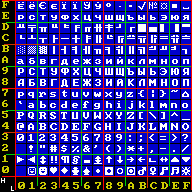Related Research Articles
ISO/IEC 8859-11:2001, Information technology — 8-bit single-byte coded graphic character sets — Part 11: Latin/Thai alphabet, is part of the ISO/IEC 8859 series of ASCII-based standard character encodings, first edition published in 2001. It is informally referred to as Latin/Thai. It is nearly identical to the national Thai standard TIS-620 (1990). The sole difference is that ISO/IEC 8859-11 allocates non-breaking space to code 0xA0, while TIS-620 leaves it undefined.

Code page 855 is a code page used under DOS to write Cyrillic script.

Code page 866 is a code page used under DOS and OS/2 in Russia to write Cyrillic script. It is based on the "alternative code page" developed in 1984 in IHNA AS USSR and published in 1986 by a research group at the Academy of Science of the USSR. The code page was widely used during the DOS era because it preserves all of the pseudographic symbols of code page 437 and maintains alphabetic order of Cyrillic letters. Initially, this encoding was only available in the Russian version of MS-DOS 4.01 (1990) and since MS-DOS 6.22 in any language version.
Windows-1257 is an 8-bit, single-byte extended ASCII code page used to support the Estonian, Latvian and Lithuanian languages under Microsoft Windows. In Lithuania, it is standardised as LST 1590-3, alongside a modified variant named LST 1590-4.
Code page 852 is a code page used under DOS to write Central European languages that use Latin script.
Code page 865 is a code page used under DOS in Denmark and Norway to write Nordic languages.
Code page 860 is a code page used under DOS in Portugal to write Portuguese and it is also suitable to write Spanish and Italian. In Brazil, however, the most widespread codepage – and that which DOS in Brazilian portuguese used by default – was code page 850.
Code page 863 is a code page used under DOS in Canada to write French although it lacks the letters Æ, æ, Œ, œ, Ÿ and ÿ.
Code page 857 is a code page used under DOS in Turkey to write Turkish.

Code page 737 is a code page used under DOS to write the Greek language. It was much more popular than code page 869 although it lacks the letters ΐ and ΰ.
Code page 869 is a code page used under DOS to write Greek language. It is also called DOS Greek 2. It was designed to include all characters from ISO 8859-7.
Code page 861 is a code page used under DOS in Iceland to write the Icelandic language.
Code page 862 is a code page used under DOS in Israel for Hebrew.
Code page 720 is a code page used under DOS to write Arabic in Egypt, Iraq, Jordan, Saudi Arabia, and Syria. The Windows (ANSI) code page for Arabic is Windows-1256.
Code page 851 is a code page used under DOS to write Greek language although it lacks the letters Ϊ and Ϋ. It covers the German language as well. It also covers some accented letters of the French language, but it lacks most of the accented capital letters required for French. It is also called MS-DOS Greek 1.
Code page 912 is a code page used under IBM AIX and DOS to write the Albanian, Bosnian, Croatian, Czech, English, German, Hungarian, Polish, Romanian, Serbian, Slovak, and Slovene languages. It is an extension of ISO/IEC 8859-2.
Code page 915 is a code page used under IBM AIX and DOS to write the Bulgarian, Belarusian, Russian, Serbian and Macedonian but was never widely used. It would also have been usable for Ukrainian in the Soviet Union from 1933–1990, but it is missing the Ukrainian letter ge, ґ, which is required in Ukrainian orthography before and since, and during that period outside Soviet Ukraine. As a result, IBM created Code page 1124. It is an extension of ISO/IEC 8859-5.
Code page 856, is a code page used under DOS for Hebrew in Israel.
Code page 921 is a code page used under IBM AIX and DOS to write the Estonian, Latvian, and Lithuanian languages. It is an extension of ISO/IEC 8859-13.
Code page 922 is a code page used under IBM AIX and DOS to write the Estonian language. It is an extension and modification of ISO/IEC 8859-1, where the letters Ð/ð and Þ/þ used for Icelandic are replaced by the letters Š/š and Ž/ž respectively. This matches the encoding of these letters in Windows-1257 and ISO/IEC 8859-13.
References
- ↑ Character Sets, Internet Assigned Numbers Authority (IANA), 2018-12-12
- ↑ "CCSID 775 information document". Archived from the original on 2016-03-27.
- 1 2 "OEM 775". Go Global Developer Center. Microsoft. Retrieved 3 Nov 2011.
- ↑ "Code Page 775 MS-DOS Baltic Rim". Developing International Software. Microsoft. Retrieved 3 Nov 2011.
- ↑ "Code page 775 information document". Archived from the original on 2016-03-17.
- ↑ "Rašmenų koduotės". Lietuvių kalba informacinėse technologijose.
- ↑ "LST 1590-1". Rašmenų koduotės.
- ↑ "cp775_DOSBaltRim to Unicode table" (TXT). The Unicode Consortium. Retrieved 3 Nov 2011.
- ↑ Code Page CPGID 00775 (pdf) (PDF), IBM
- ↑ Code Page CPGID 00775 (txt), IBM
- ↑ International Components for Unicode (ICU), ibm-775_P100-1996.ucm, 2002-12-03